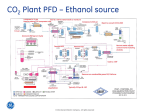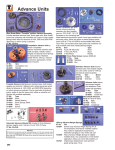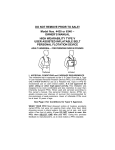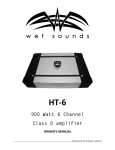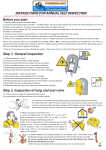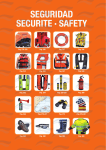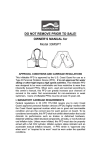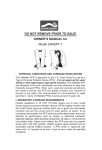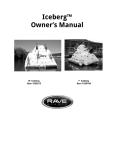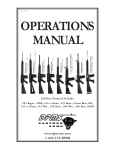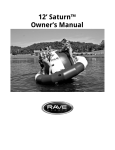Download 90-00001-1 USCG Owner`s Manual Rev C 5-01
Transcript
OWNER’S MANUAL Wear it. Live with it.™ Model Number(s): FT-HRA-R5-1,2,3,4,5,6,7 DO NOT REMOVE PRIOR TO SALE NOTE: DEVICE IS PACKED UNARMED and MUST BE ARMED IN ACCORDANCE WITH THIS MANUAL. TABLE OF CONTENTS CONDITIONS OF TYPE V APPROVAL __________________________ 1 SERVICE RECORD INFORMATION _____________________________ 2 I. PRODUCT DESCRIPTION ___________________________________ 3 II. SPECIAL CONDITIONS FOR MANUAL/AUTO INFLATOR __________ 4 III. PRE-DONNING INSTRUCTIONS 1. Inspecting your pfd for damage ___________________________ 7 2. Examining Inflation Mechanism Status Indicators _____________ 7 3. Examining CO2 Cylinder Face for Puncture Hole ______________ 7 4. Halkey-Roberts Auto Inflator Rearming Instructions ________ 8 5. Conversion of Auto Inflator to Manual Only Operations_____ 10 6. Attaching the Float-Tech PFD to the Jacket_______________ 12 IV. DONNING INSTRUCTIONS A. Wearing Float-Tech as a Jacket (PFD zipped into Jacket)_____ 13 B. Wearing Float-Tech as a PFD (Without Jacket) _____________ 14 V. INFLATION INSTRUCTIONS _________________________________ 15 VI. ABANDON SHIP INSTRUCTIONS_____________________________15 VII. DEFLATION INSTRUCTIONS _______________________________ 16 VIII . CARE AND CLEANING ___________________________________ 17 IX. INSPECTION A. User Inspection ______________________________________ 17 B. Certified Inspection ___________________________________ 18 X. FREQUENTLY ASKED QUESTIONS A. HOW DO YOU “WATER TEST” YOUR PFD? _______________ 19 B. WHERE CAN I PURCHASE A REARMING KIT? ____________ 19 C. WHERE DO I SEND MY PFD FOR INSPECTION AND/OR SERVICE? _____________________________________ 20 D. CAN I WEAR MY FLOAT-TECH PFD WITH OTHER JACKETS? _________________________________________ 20 XI. ADDITIONAL INFORMATION A. WEAR YOUR PFD ____________________________________ 21 B. HYPOTHERMIA ______________________________________ 21 CONTACT INFORMATION _____________________________________ 23 This device is a USCG approved Type V providing Type III performance characteristics. This inflatable PFD is not approved for high impact activities, such as water skiing. As a Personal Flotation Device (PFD) that was designed to be more comfortable and less restrictive to the wearer, the device must be worn, used, and serviced according to this owner’s manual. This Inflatable PFD can increase your chances of survival in the water, but is not recommended for weak or non-swimmers. According to Coast Guard regulations, users of inflatable PFD’s must be at least 16 years of age or over 80 lbs. NOTE: DEVICE IS PACKED UNARMED and MUST BE ARMED IN ACCORDANCE WITH THIS MANUAL. Conditions For This Type V Approval Conditional approvals are granted by the U.S. Coast Guard for PFDs that: 1. Do not meet all the requirements for approval under the Type I through IV categories but offer other significant safety features, or Have features or uses not found in Type I through Type IV PFDs that require special user knowledge. 2. The conditions let the user overcome design traits that would otherwise prevent approval. Approved Only When Worn This PFD has the Approved Only When Worn condition on it's approval because if it is not worn whenever above deck and underway, it's less likely to be in working order and cannot be counted as a PFD to meet the carriage requirements on your boat. This manual/automatic inflatable PFD requires more frequent checks than ones that have inherently buoyancy. Wearing this PFD will: 1. Ensure it gets the extra attention associated with use, 2. Ensures the user knows the advantages and disadvantages of the device, and 3. Increase safety enormously because you have it when needed. Read the discussion under SPECIAL CONSIDERATION FOR THE MANUAL/AUTOMATIC INFLATOR ON THIS PFD and understand its implications on your safety. SERVICE RECORD DATE: SERVICED BY: COMMENTS: DATE: SERVICED BY: COMMENTS: DATE: SERVICED BY: COMMENTS: DATE: COMMENTS: SERVICED BY: I. Product Description Float-Tech is a unique product in that it consists of two overall components. The first component is the zip-in inflatable Personal Flotation Device (PFD), which is referred to as the “PFD” throughout the remainder of this manual. The second component is called the “Jacket” or “Jacket without sleeves” (since the user will have the ability to zip the sleeves off the Jacket). The PFD has the inflatable life jacket technology and devices that makes it a fully functioning personal flotation device while worn by itself or while zipped into specifically approved Jackets. The list of approved Jackets that are integrable with the Float-Tech PFD is provided at the USCG website as well as www.floattech.com, or by contacting the manufacturer. See contact information on page 23 of this manual. REFER TO PAGE 5 & 6 FOR A DIAGRAM OF THESE TWO MAIN COMPONENTS SIZE CHART SIZES: CHEST: XS 30-32 in (76-81 cm) S 34-36 in (86-91 cm) M 38-40 in (97-102 cm) SIZES: CHEST: L XL 2XL 3XL 42-44 in 46-48 in 50-52 in 54-56 in (107-112 cm) (117-122 cm) (127-132 cm) (137-142 cm) II. Special Consideration for the manual/Automatic INFLATOR ON THIS PFD. Premature automatic inflation creates several risks that you must address to avoid drowning. The PFD might not be armed when needed, either knowingly or unknowingly. Much less common but also important are: 1. Double inflation could damage the PFD, 2. Inflation when stored in a tight space could damage the PFD, and 3. The PFD could inflate when you're in an awkward place or position. Owners of this type of inflatable PFD must understand the unique characteristics of the product so that they can use them safely. You must learn how to properly arm the PFD. Why: An improperly armed mechanism may not inflate the chamber. This PFD will not provide buoyancy without being inflated. You must check the status of the mechanism and the CO2 cylinder before each outing. If the cylinder cap is punctured there will be no gas to inflate the PFD. Also, if the cylinder is deformed in any way, there may not be gas to inflate the PFD. Why: Why: This PFD will not float you unless it can be inflated. You usually cannot be sure that no one else inflated the PFD recently and did not replace the cylinder. Why: Premature inflations that occur on a stored product may go unnoticed since the CO2 gas will permeate the chamber fabric within a few days, leaving a deflated chamber. Why: U.S. Coast Guard studies have shown high percentages of unserviceable inflatable PFDs with used cylinders in them when used by recreational boaters. This PFD is designed to allow you to re-arm it in the "Manual Inflation Only" mode. Do not make any other alterations or modifications to the inflator mechanism. Why: Altering the mechanism may result in the failure of the device to inflate and provide the necessary buoyancy to float you. Why: Altering the PFD will void the U.S. Coast Guard approval. Please read the entire owners manual for more details about the use and care of this Inflatable PFD. JACKET (with Inflatable Liner Attached) 1. LANYARD FOR MANUAL ACTIVATION (only visible when inflatable liner is attached) 2. ORAL INFLATION TUBE – ACCESSIBLE THROUGH VERTICAL CHEST ZIPPER 3. PULL DOWN WINDOW - ALLOWS VIEWABLE ACCESS TO ARMING CONDITIONS OF DEVICE 4. ADJUSTABLE SHOCK CORD 5. REFLECTIVE PIPING ACROSS SLEEVES AND CHEST 6. GUSSETED CHEST AND UNDERARM TO ALLOW FOR COMFORT DURING INFLATION OF PFD 7. TWO WAY ZIPPER, ALLOWS EASY ACCESS TO READJUST WAIST STRAP ON PFD 8. STOWABLE HOOD 9. ZIP ON/OFF SLEEVES FOR COMFORT DURING VARYING WEATHER CONDITIONS PERSONAL FLOTATION DEVICE (PFD) a. HALKEY-ROBERTS V90000 MANUAL/AUTO INFLATOR, CONVERTIBLE TO MANUAL WITH CAP b. ORAL INFLATION TUBE c. CHEST BUCKLE d. WAIST BUCKLE (ADJUSTABLE) e. ELASTIC POCKET FOR SPARE CO2 AND MANUAL CONVERSION CAP f. VISLON ZIPPER FOR ATTACHING AS A PFD TO THE JACKET III. Pre-donning Instructions Check the following before usage: • Inspect PFD for Damage • Examine Inflation Mechanism status indicators • Examine CO2 Cartridge Face for puncture hole 1. Inspecting your PFD for Damage Inspect the PFD for rips, tears or punctures. The Inflatable Chamber and Liner should be inspected at the beginning of each boating season, and every two months during each season. Damage indicates that the Inflatable Chamber may not function properly to act as a Personal Flotation Device. If such defects are present, discontinue use of the PFD, and have the PFD inspected by an authorized repair facility (for authorized repair information, please contact the manufacturer. See contact information on page 23 of this manual). To perform the leak test procedure please refer to the section User Inspection (section V.A). 2. Examine Inflation Mechanism Status Indicators The status indicator check instructions are provided on the device inside a pocket near the inside of the left chest. The V90000 Automatic inflator used with Float-Tech has two indicators: one for the Jerk to Inflate Actuating Lever and one for the Automatic Bobbin. The status Indicators will tell you if the mechanism is ARMED and ready for activation. In addition, the CO2 Cartridge Face should be checked for a puncture hole. The color of the Status Indicators have the following meanings: Green = OK = Ready Red = NOT READY = See ‘Rearming Instructions’ IF ANY INDICATOR IS RED, IMMEDIATELY REARM 3. Examine CO2 Cylinder Face for puncture hole You must verify that the CO2 Cylinder installed is of correct size and has not been previously fired. To examine the cylinder, unscrew it, Visually examine the flat surface on the threaded end. If there is any visual damage on the flat surface the cylinder MUST BE REPLACED. If the cylinder is OK, you must properly screw it back into the mechanism. CAUTION: DO NOT strike cylinder with sharp objects THE CO2 CARTRIDGE MUST BE REARMED AFTER EACH USE. Proper cylinder size includes both thread size and CO2 gram weight. For this Model the CO2 Cylinder is 24 Grams, and 1/2 inch thread as provided in Leland Rearming Kit # V90000-84204Z (Referenced Kit includes a 24 gram 1/2 inch thread CO2 cylinder, bobbin, and green indicator clip). 4. V90000 Halkey-Roberts Auto Inflator Rearming Instructions Step A1. Unscrew used CO2 cylinder in a counterclockwise direction and to avoid confusion later in the rearming process, discard the old CO2 cylinder now. Do not insert unused or new cylinder at this time. It will discharge. Step A2. Unscrew the clear cap on the bottom of the inflator in a counter-clockwise direction. Remove and discard the used plastic bobbin element. Step A3. Rinse any white residue remaining in or on the cap and from the housing of the inflator. Shake dry or allow to air dry. (Fresh water rinse is desirable.) Step A4. Check the date on the side of the bobbin to ensure that the bobbin is less than 3 years old. Insert the fresh bobbin, lining up the slots on the bobbin with the ridges inside the housing. Replace clear cap inflator securely, but do not over tighten. (The indicator at the bottom of the cap will change from red to green when the bobbin is properly loaded. The inflator will not work in the automatic mode without the bobbin.) Step A5. If manual lever is not locked or the green indicator clip is missing, close the lever within the inflator body and carefully insert a new green indicator clip so that it fully covers the red lever on the body by aligning the arms on the clip with the slots in the inflator housing. Push firmly in the middle of the clip to snap into place. Step A6. Look into the threaded cylinder. Receiver and view the gasket. Replace if worn. This is a 3/8-inch gasket. Step A7. Inspect the face of the new cylinder. Be sure it is smooth and has no holes or scratches. There is a gross weight on the cylinder. If you have any question about cylinder integrity, weigh the cylinder on a small scale, such as a postage scale. Compare the weight printed on the cylinder to the actual weight. If they do not match, get another cylinder. Step A8. Screw the new properly sized cylinder in a clockwise direction into the cylinder receiver firmly. DO NOT OVER TIGHTEN, but ensure the fit is snug. Caution: A9. Check cylinder face and ensure that the arming indicators on your inflator are green before each boating trip. They will tell you if there is need for service. Leland Rearm Kit # V90000-84121Z or approved equal. Re-Arming Kit includes a 24 gram CO2 cylinder with 1/2 inch thread, bobbin, and a green indicator clip. 5. Conversion of V90000 Auto-Inflator to Manual Only Operation Remove the yellow manual cap and spare 24 gram CO2 cylinder from its packaging. Step M1. If the manual/auto unit has become wet and prematurely inflated, deflate the PFD (see page 16). Step M2. Unscrew CO2 cylinder in a counterclockwise direction and to avoid confusion later in the rearming process, discard the CO2 cylinder if it has been previously used or damaged. If the CO2 cylinder is unused place it aside until Step M6 below. Do not insert unused cylinder at this time. It will discharge. Step M3. Unscrew the clear cap on the bottom of the inflator housing in a counterclockwise direction and place-it in a safe location for future use. Remove and discard the plastic bobbin element, if used, damaged, or shows signs that it has gotten wet. If bobbin element is unused and undamaged, save the bobbin in a safe location (plastic zip-lock bag) for future use in the auto-inflator. Step M4. Screw on the yellow cap (it has the words "MANUAL:' printed on side), DO NOT OVER TIGHTEN. The inflator has now been converted to manual-only, rip-cord activated CO2 inflation. Step M5. If manual lever is not locked or the green indicator clip is missing, close the lever within the inflator body and carefully insert a new green indicator clip so that it fully covers the red lever on the body by aligning the arms on the clip with the slots in the inflator housing. Push firmly in the middle of the clip to snap into place. Step M6. Screw the unused or new 24 gram cylinder in a clockwise direction into the cylinder receiver firmly. DO NOT OVER TIGHTEN, but ensure the fit is snug. Leland Rearm Kit # V90000-84121Z or approved equal. Re-Arming Kit includes a 24 gram CO2 cylinder with 1/2 inch thread, bobbin (not used in manual armed condition), and a green indicator clip. Note: The yellow manual cap does not contain a spring, and must be used to convert the inflator to manual-only operation. Attempting to use the clear cap without a bobbin would instantly puncture the CO2 cylinder. 6. Attaching the Float-Tech PFD to the Jacket For attachment/removal of the PFD , follow these six steps: Step 1: Check status of inflator and arm if required. Roll Velcro cover from right chest to left side and Velcro the cover in the depicted location. The viewable inflator cover is only to be used when the PFD is worn without the jacket.” Step 2: Lay the jacket flat and open on flat surface. Step 3: Lay the PFD such that oral tube is on the left chest. Unzip oral inflation zipper opening and place oral tube through opening over top of the elastic strap and then close zipper. Step 4: Attach the PFD to inner jacket zipper and zip ½ of the full distance. Step 5: Locate the clear viewing window on right chest of jacket, pull open the viewing panel and identify overlap of window. Place the n end of “Jerk to Inflate” lanyard tab through slot. Next place the inflator end into the black elastic retaining pocket. Step 6: Zip the PFD zipper the remaining distance and follow arming and examination steps shown previously. Ensure that “Jerk to Inflate” lanyard is visible after donning. Jacket should be stowed on a hanger or folded and placed in a dry area. IV. Donning Instructions A. Wear Float-Tech as a Jacket (PFD zipped into Jacket) Step 1: Secure the front buckle(s) and adjust the lower buckle until comfortably snug fit. Jacket may be worn as zipped or unzipped, however, both buckles need to be secured while wearing the device. To loosen or tighten the PFD while the jacket is zipped, it is best to use bottom two-way jacket zipper to access the bottom PFD buckle strap for adjustment purposes. Step 2: After donning, locate the Jerk to Inflate tab for the mechanism, it should protrude from the Jacket and be visible. Make sure that you are comfortable locating the Jerk to Inflate tab with either hand. Step 3: Prior to donning always view inflator indicators to verify that the device is active. To view the inflator within the jacket, pull right upper pocket down vertically with either hand to view window. [Refer to Arming Instructions in this manual, page 8 for auto inflator arming instructions, and page 10 for converting auto inflator to manual inflator.] Please note: 1. When the PFD is attached to the Jacket, the attached Velcro cover/ window on the PFD must be rolled over into an open position as to expose the inflator. The inflator will then, be more accessible and viewable through the Jacket’s viewing window when the PFD is zipped into the Jacket. 2. Always wear your Float-TechTM PFD in Float-Tech approved apparel. Do not wear Float-Tech under any clothing other than that indicated on the approved list. The approved outerwear list can be found on the USCG Website or www.floattech.com, or contact the manufacturer. (See contact information on page 23 of this manual) 3. To don while inflated (with PFD in Jacket)) follow Step 1 above. B. Wear Float-Tech as a stand alone PFD (no Jacket) Step 1: Secure the front buckle(s) and adjust until comfortably snug fit. Both buckles need be secured while wearing the device. Step 2: After donning, locate the Jerk to Inflate tab for the mechanism, it should protrude from the PFD and be visible. Make sure that you are comfortable locating the Jerk to Inflate tab with either hand. Step 3: Prior to inflating always view indicator to verify that the device is active. View inflator through clear window in the PFD. [Refer to Arming Instructions in this manual, page 8 for auto inflator arming instructions, and page 10 for converting auto inflator to manual inflator.] , Step 4: When wearing the Float-Tech PFD alone, secure the oral inflation tube to the PFD with Velcro loop. This will secure the oral inflation tube to the core and reduce wear on the oral tube. Please note: To don the PFD alone (not in jacket) while inflated, follow Steps 1 and 4 in the this above section. CAUTION: Bulky clothing may affect the ability of this PFD to turn the wearer to face-up position in water. The Float-TechTM PFD is designed to fit with the approved Jackets only. DO NOT wear the PFD under any other jacket or apparel. The approved outerwear list can be found on the USCG Website or www.floattech.com, or contact the manufacturer directly. See contact information on page 23 of this manual. V. Inflation Instructions Auto Inflation: If armed in auto mode, PFD will auto inflate upon submersion in water. Manual Inflation: If armed in auto mode or manual mode the PFD can be inflated by grasping the JERK TO INFLATE tab and rapidly pull downward. CAUTION: Do not manually inflate after the chamber is ALREADY inflated. This may cause damage to the PFD. Oral Inflation: 1. Unzip the zipper on the left chest side of the jacket. 2. Grasp the Red Oral Tube and bring to mouth. 3. Blow air into the Oral Tube until the PFD is firm. Note: Oral inflation may be required if PFD is NOT firm due to cold temperatures at or below 40° F (4° C). VI. Abandon Ship Instructions 1. Inflate PFD manually as described in Section V (previous section). 2. Hold collar area, of the PFD if worn alone, or collar area of the Jacket if PFD is zipped into jacket. Then jump into water. (See diagram below). VII. Deflation Instruction 1. LOCATE INFLATION CAP on oral tube. 2. OPEN INFLATION CAP 3. INVERT CAP 4. DEPRESS INFLATION CAP INTO TUBE 5. Assist in deflation by rolling jacket and/or PFD tightly, starting from the inflator side of the lifejacket and roll toward the oral tube, Be sure to remove as much inflation medium as possible. Deflation may be easier by removing the PFD from the jacket first. 6. Upon deflating the bladder replace the cap onto the oral tube. 7. Reposition oral tube into Velcro loop if being worn as PFD alone or reposition oral tube into Jacket pocket and re-zip pocket. (Do not use Velcro loop when repositioning oral tube back into Jacket pocket). Caution: All CO2 or inflation medium must be removed from the PFD after inflation occurs to ensure that the PFD is not over inflated and damaged the next time the PFD is inflated. VIII. Care and Cleaning REMOVE THE PFD BEFORE ALL CLEANINGS OF THE JACKET. THE JACKET SHOULD BE CLEANED SEPARATELY FROM THE PFD. Machine wash cold tumble dry on low or delicate the jacket only, not the PFD. For the PFD: - Do not Machine Wash Do not Machine Dry Do not Dry Clean Do not use SOLVENT based cleaners Do not Bleach Drying: If the PFD or the jacket is wet, place both separately, the jacket and the PFD on coat hangers to allow for thorough drying. Do not use any heat source, or direct sunlight to dry. Cleaning: For the PFD, rinse well with fresh (not salt) water, damp wipe with mild detergent. Any oil or grease should be removed. The service life of this PFD depends upon how it is used and cared for. When not in use the PFD should be stored away from direct sunlight, high temperature, and high humidity. These elements will degrade the life of the materials. The PFD should be stored in a clean, cool, dry area. IX. Inspection A. User Inspection Check your PFD between outings to ensure that the CO2 Cartridge is properly armed; that it is free from rips tears or holes and that all seams are securely sewn; and all fabric, straps, buttons and zippers are still strong. LEAK TEST – This test should be performed every two months and at the start of each boating season. • • • Orally inflate the PFD and leave to rest for 12 hours. If the PFD remains full of air after 12 hours the chamber is operational. If the PFD deflates, the device is no longer operating. Please contact the manufacturer or certified inspector. ORAL VALVE – Remove dust protection cap on the oral inflation tube.. With the PFD inflated, push down with tab on the cap to test valve. The Valve should depress easily and return to close position and reseal upon release. STRAPS AND LINER – Inspection should be performed each outing. Examine fabric liner and inflation bladder in the PFD. Examine snaps, buckles, zippers, attachments, and seams for fading. Fading can indicate a loss of material strength. For ANY signs of damage, please contact the manufacturer or certified inspector.. B. Certified Inspection Float-Tech Inc. recommends that the manufacturer or certified inspector inspect the PFD at least every 24 months. For a certified inspection, contact Float-Tech Inc. for instructions (details available where product is purchased). For more details about certified inspections, information can be obtained by calling 1-518-266-0964. X. Frequently Asked Questions Drownings are the leading cause of fatalities involving recreational boating. In approximately 80 percent of all boating fatalities, the victims were not wearing a PFD. A PFD provides flotation to help keep your head above water. Most adults only need an extra 7 to 12 pounds of flotation to keep their heads above water. This inflatable PFD is much less bulky and more comfortable to wear than other PFD types. But since this inflatable PFD is not inherently buoyant, it provides flotation only when inflated. Familiarize yourself with the use of this PFD so you know what to do in an emergency. Get in a habit of wearing this PFD. A. How do you ‘water test’ your PFD? 1. Manual Inflator 1) To test your inflatable PFD armed in manual mode, you will need: Your fully armed PFD, and rearming kit approved for your PFD. (Rearming Kit includes a 24 gram CO2 cylinder with 1/2 inch thread and a green indicator clip, see pages 10-11). 2) Put on the PFD. 3) Actuate the inflation system by jerking firmly downward on the pull tab. The PFD should fully inflate within 5 seconds. 4) Get into shallow water, just deep enough that you can stand with your head above the surface. 5) See if the PFD will float you on your back or just slightly back of vertical. In a relaxed floating position, verify that your mouth is well above the water’s surface. Note the effect of where you hold your legs on how you float. 6) Get out of the water and remove the PFD. Remove the used CO2 cylinder from the PFD inflator. Completely deflate the PFD using the oral inflator. 7) Let the PFD dry thoroughly. REARM AND REPACK the PFD in accordance with the manufacturer’s instructions! Refer to section 5, page 10 of this manual. 2. Automatic Inflator 1) To test your inflatable PFD armed in automatic mode, you will need: Your fully armed PFD, and rearming kit approved for your PFD. (Rearming Kit includes a 24 gram 1/2 inch thread CO2 cylinder, bobbin, and green indicator clip, see page 8-9). 2) Put on the PFD. 3) Get into shallow water, just deep enough that you can stand with your head above the surface. Once the inflator is under water the PFD should automatically, fully inflate within 10 seconds. 4) See if the PFD will float you on your back or just slightly back of vertical. In a relaxed floating position, verify that your mouth is well above the water’s surface. Note the effect of where you hold your legs on how you float. 5) Get out of the water and remove the PFD. Remove the used CO2 cylinder and the used bobbin (automatic inflator element) from the PFD inflator. Deflate the PFD using the oral inflator. 6) Let the PFD dry thoroughly. REARM AND REPACK the PFD in accordance with the manufacturer’s instructions! Refer to section 4, page 8 of this manual. 3. Oral Inflator (Armed in Manual Mode) 1) To test your inflatable PFD armed in manual mode, you will not need any spare parts, or rearming kits. Refer to section 5, page 10 for arming instructions. 2) Remove the CO2 cylinder, to prevent inadvertent activation of the manual inflation system which could potentially damage the PFD. Inspect the threaded end to confirm it is un-used. 3) Put on the PFD. 4) Get into shallow water, just deep enough that you can stand with your head above the surface. 5) If you are a weak swimmer or non-swimmer, inflate the PFD partially so that you are supported well enough to be able to complete inflation without touching bottom. Note this level of inflation because it is the minimum needed for you to safely use this inflatable PFD. 6) Fully inflate the PFD using the oral inflator. 7) See if the PFD will float you on your back or just slightly back of vertical. In a relaxed floating position, verify that your mouth is well above the water’s surface. Note the effect of where you hold your legs on how you float. 8) Get out of the water and remove the PFD. Completely deflate the PFD using the oral inflator. 9) Let the PFD dry thoroughly. REARM AND REPACK the PFD in accordance with the manufacturer’s instructions! See sections 4 and 5 pages 8-11 in this manual for arming instructions. B. Where can I purchase a rearming Kit? Kits can be ordered directly from Float-Tech Inc. by calling 1-518-266-0964 or going to www.inflatablepfd.com. Rearming kits may also be obtained from retailers who carry our products. Rearming kits suggested are: Leland Rearming Kit # V90000-84204Z for automatic rearming, (Referenced Kit includes a 24 gram 1/2 inch thread CO2 cylinder, bobbin, and green indicator tab). Leland Rearming Kit # 840AMU-84204Z for manual rearming, (Referenced Kit includes a 24 gram 1/2 inch thread CO2 cylinder and green indicator tab). Note: Many manufacturer’s provide rearming kits and may provide one that works with this device. Consult your retailer for help. C. Where do I send my PFD for inspection and/or service? Refer to “Section B Certified Inspection” page 18 for details. D. Can I wear my Float-TechTM PFD with other Jackets? NO, the Float-TechTM PFD is designed to fit with the approved Jackets only. DO NOT wear the liner under any other jacket or apparel. Refer to our website www.floattech.com or contact us directly for a list of approved outer jackets for this device. Contact information is on page 23 of this manual. XI. Additional Information A. WEAR YOUR PFD In approximately 80 percent of all boating fatalities, the victims were not wearing a PFD. Most fatal accidents happen on calm sunny days. This inflatable PFD is much more comfortable to wear than other PFD types. Get into the habit of wearing this PFD. Non-swimmers and children especially should wear a hybrid or non-inflatable PFD at all times when on or near the water. B. HYPOTHERMIA Prolonged exposure to cold water causes a condition known as hypothermia – a substantial loss of body heat, which leads to exhaustion and unconsciousness. Most drowning victims first suffer from hypothermia. The following chart shows the effects of hypothermia. HOW HYPOTHERMIA AFFECTS MOST ADULTS Water Temperature °C (°F) 0.3 (32.5) 0.3 to 4 (32.5 to 40) 4 to 10 (40 to 50) 10 to 16 (50 to 60) 16 to 21 (60 to 70) 21 to 27 (70 to 80) Over 27 (Over 80) Exhaustion or Un- Expected Time of Survival consciousness UNDER 15 MIN 15 TO 30 MIN 30 TO 60 MIN 1 TO 2 HOURS 2 TO 7 HOURS 2 TO 12 HOURS INDEFINITE UNDER 15 TO 45 MIN 30 TO 90 MIN 1 TO 3 HOURS 1 TO 6 HOURS 2 TO 40 HOURS 3 HOURS TO INDEFINITE INDEFINITE PFDs can increase survival time because they allow you to float without using energy treading water and because of their insulating properties. Naturally, the warmer the water, the less insulation you will require. When operating in cold waters [below 60°F (15.6°C)] you should consider using a coat or jacket style PFD or a Type V Thermal Protective PFD as they cover more of the body than the vest or belt style PFDs. Some Points to Remember About Hypothermia Protection: 1. Always wear your PFD. Even if you become incapacitated due to hypothermia, the PFD will keep you afloat and greatly improve your chances of rescue. 2. Do not attempt to swim unless it is to reach a nearby craft, fellow survivor, or a floating object on which you can lean or climb. Swimming increases the rate of body heat loss. In cold water, drown-proofing methods that require putting your head in the water are not recommended. Keep your head out of the water. This will greatly lessen heat loss and increase your survival time. 3. Use the standard H.E.L.P. position when wearing an inflatable PFD, drawing the legs up to a seated position, because doing so will help you conserve body heat. 4. Keep a positive attitude about your survival and rescue. This will improve your chances of extending your survival time until rescued. Your will-to-live does make a difference! 5. If there is more than one person in the water, huddling is recommended while waiting to be rescued. This action tends to reduce the rate of heat loss and thus increase the survival time. If you need more information about PFDs and safe recreational boating, contact your state boating authority, US Coast Guard, US Power Squadron, Red Cross, or call the Coast Guard Customer InfoLine at 1-800-368-5647, or the Free Boating Course number at 1-800-336-BOAT (in VA, 1-800-235-BOAT.) If you have any questions about the initial arming, rearming, repacking please contact the manufacturer. Contact Information: Address: Float-Tech Inc. 216 River Street Troy, NY 12180 Phone: 518-266-0964 Fax: 518-266-0318 Website: www.floattech.com If you have any additional questions or concerns please feel free to contact us through the information provided below. Boat Safe! 90-00001-1 REV C 4-3-05




























